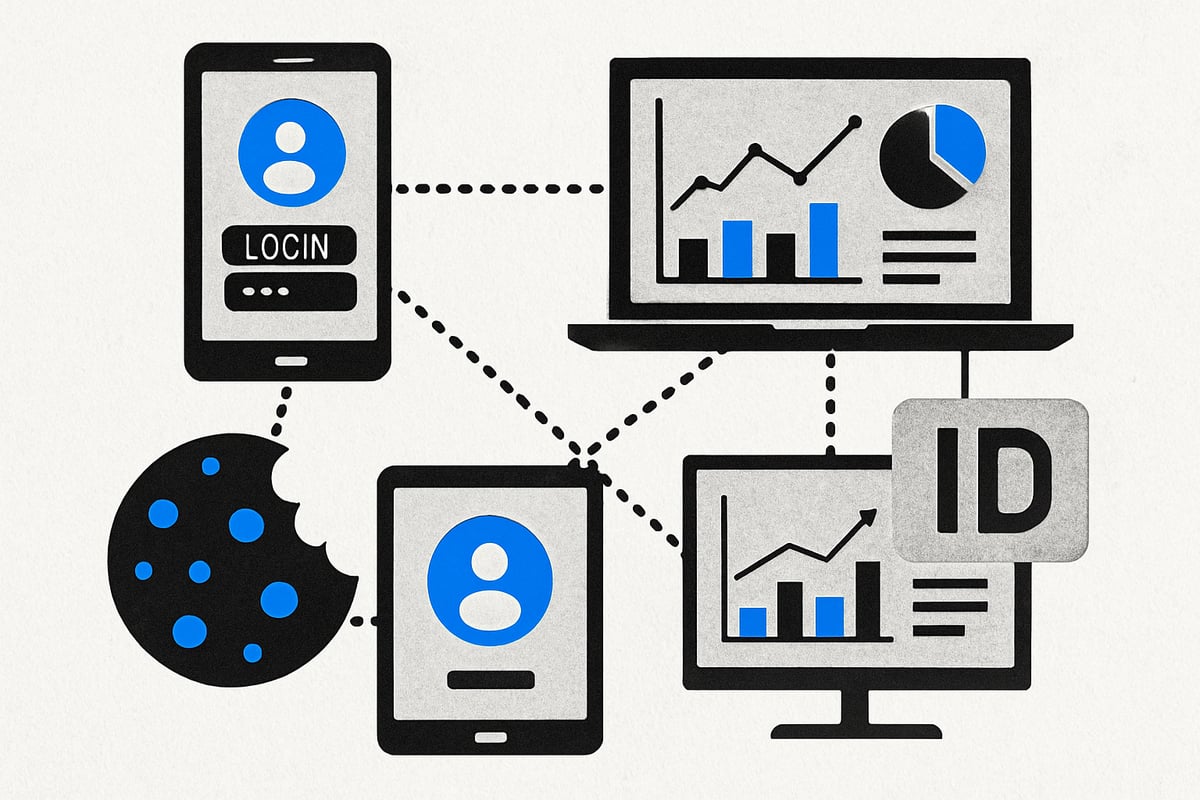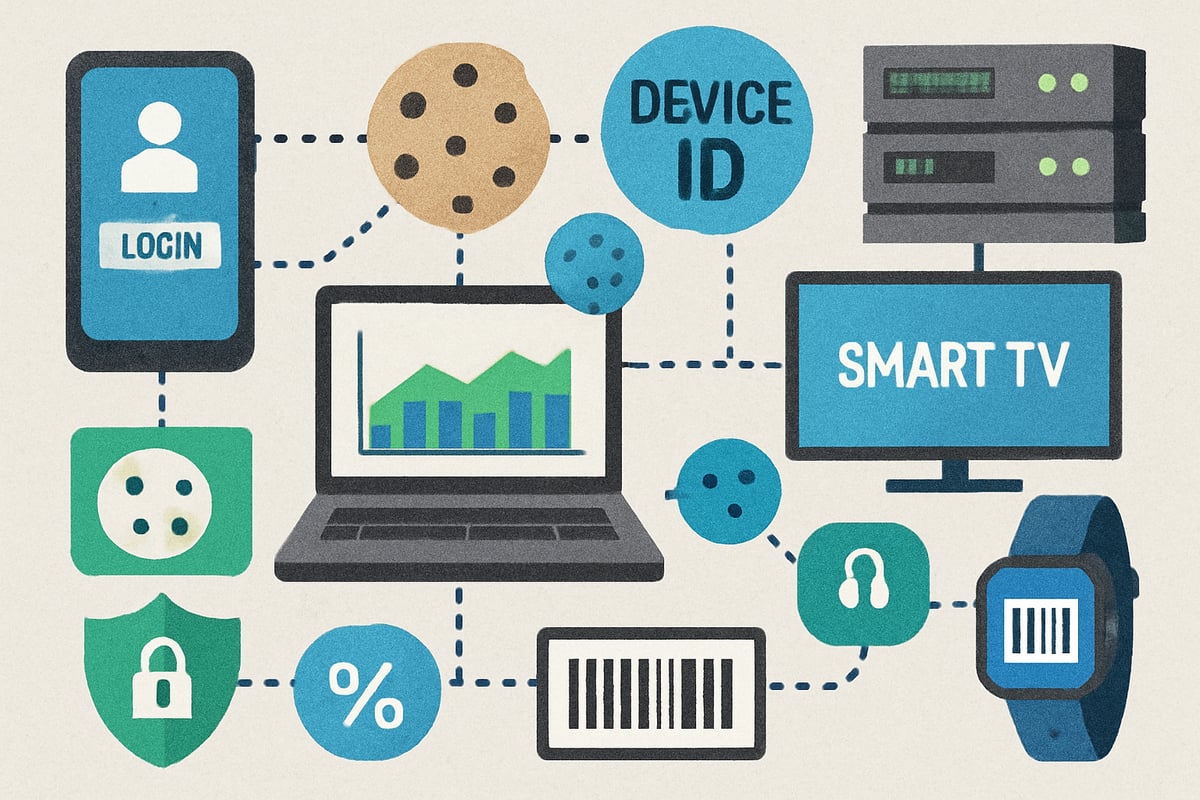- Date
Cross Device Tracking Guide: Strategies & Insights for 2025
 Andrii Romasiun
Andrii Romasiun
Tracking the entire user journey across smartphones, tablets, desktops, and smart TVs is more difficult than ever. In 2023, the average U.S. household had 17 connected devices, according to Pew Research Center. This complexity makes cross device tracking essential for any business aiming to understand and engage its audience in 2025.
Seamless cross-device experiences not only drive conversions but also build customer loyalty. Yet, privacy laws and technology shifts mean the rules are constantly evolving.
This guide demystifies cross device tracking, giving marketers, analysts, and digital leaders practical strategies and the latest insights. You will learn about core concepts, tracking methods, business benefits, privacy and legal considerations, step-by-step implementation, and the trends that will shape 2025.
Ready to optimize your marketing, analytics, and user experience? Dive in and future-proof your approach.
Understanding Cross Device Tracking: Core Concepts & Definitions
Consumers today use several devices to interact with brands, making it essential to understand cross device tracking. This section covers its definition, core methods, key terms, and how the technology has evolved.

What is Cross Device Tracking?
Cross device tracking is a set of technologies and strategies that connect user interactions across multiple devices, such as smartphones, desktops, tablets, and smart TVs.
It works by linking identifiers like logins, device IDs, cookies, or even ultrasonic signals to create a unified profile for each user. For example, a user might see an advertisement on their phone, research a product on their desktop, and finally make a purchase on a tablet. Cross device tracking helps businesses connect these touchpoints into a single journey.
Key players in cross device tracking include technology companies, advertisers, and analytics providers. The main goal is to deliver personalized experiences, improve attribution, and enhance targeting effectiveness.
Types of Cross Device Tracking Methods
There are several methods for cross device tracking, each with unique strengths and limitations:
- Deterministic tracking: This method uses exact identifiers, such as login credentials, to match users across devices. It provides high accuracy but only works when users are signed in.
- Probabilistic tracking: Here, algorithms analyze data patterns, including device type, IP address, and browsing behavior, to infer connections between devices. This approach is useful when logins are unavailable but is less precise.
- Hybrid approaches: Many organizations combine deterministic and probabilistic data for improved results.
For instance, streaming services like Netflix rely on logins (deterministic), while ad networks might use probabilistic models to connect users when login data is missing. Each method plays a role in an effective cross device tracking strategy.
Key Terminology & Identity Spaces
Understanding cross device tracking requires familiarity with several important terms:
- User ID: A unique identifier assigned to a user, often linked to account logins.
- Device ID: A code that identifies an individual device, commonly used in mobile environments.
- Cookies: Small text files stored in a browser to track sessions and preferences. Learn more about cookies in this detailed guide.
- Google Signals: Data from users logged into Google services, used for cross device analysis.
- Behavioral modeling: Predictive techniques to fill in data gaps.
Google Analytics 4 (GA4) uses identity spaces like User-ID, Device ID, Google Signals, and Modeling to enhance tracking accuracy. Marketers and analysts rely on these terms to interpret user journeys and optimize campaigns.
The Evolution of Cross Device Tracking
Cross device tracking has evolved from simple, single-device cookies to sophisticated, multi-device solutions. As mobile devices and smart home technology proliferated, user journeys became increasingly complex, with the average household owning numerous connected devices.
This shift required new tracking approaches and sparked innovation in identity resolution. Privacy regulations have also influenced the evolution, pushing companies to adopt more transparent and user-friendly tracking standards. For a deeper look at the latest challenges and advancements, see this overview on Cross-Device Identity Resolution in 2025.
Today, cross device tracking must balance accuracy, privacy, and user trust, adapting as technology and regulations change.
Why Cross Device Tracking Matters: Benefits & Business Impact
Understanding the business impact of cross device tracking is essential for digital leaders aiming to thrive in a world where users move fluidly between devices. Let’s explore how this technology drives value across user experience, analytics, advertising, and long-term growth.

Enhanced User Experience Across Devices
Cross device tracking enables brands to deliver seamless and personalized experiences as users transition between smartphones, laptops, tablets, and smart TVs. For example, a customer might add a product to their cart on a mobile app, review it later on a desktop, and finalize the purchase on a tablet. Without a unified view, this journey would feel fragmented and frustrating.
By leveraging cross device tracking, businesses can identify and eliminate friction points in multi-device journeys. Features like persistent shopping carts and synchronized preferences help boost conversions and foster loyalty. Recent Cross-Device Shopping Path Statistics 2025 reveal that consumers expect continuity, making this capability vital for retention.
Improved Attribution & Analytics
Attribution is the backbone of effective marketing, and cross device tracking dramatically improves its accuracy. Instead of attributing a conversion solely to the last device or channel, marketers can now see the full journey—such as a user clicking an ad on mobile, researching on a desktop, and purchasing via tablet.
Cross device tracking supports advanced attribution models like last-touch, multi-touch, and data-driven approaches. This clarity allows businesses to allocate budget more effectively and understand which touchpoints truly influence results. Reliable analytics also uncover hidden patterns, optimizing campaigns for higher ROI.
Better Ad Targeting & ROI
With cross device tracking, advertisers can create unified user profiles, enabling precise targeting across platforms. Rather than serving redundant or irrelevant ads, businesses tailor messages based on holistic behavior, increasing both relevance and engagement.
This approach reduces wasted ad spend and maximizes return on investment. For instance, if a user browses a product on their phone but abandons it, retargeting can follow them to their desktop or smart TV, reinforcing the offer. The end result is smarter allocation of resources and improved campaign efficiency.
Competitive Advantage & Customer Retention
Brands that master cross device tracking gain a significant edge over competitors. In today’s landscape, consumer journeys rarely happen on a single device, and expectations for consistency are at an all-time high.
By delivering unified experiences and recognizing customers at every touchpoint, organizations build trust and foster loyalty. This not only drives repeat purchases but also positions the brand as forward-thinking and responsive to changing behaviors. Adapting to these trends is essential for long-term success in a connected world.
Cross Device Tracking Technologies & Strategies in 2025
Navigating the fast-evolving world of cross device tracking requires a clear understanding of both established and emerging technologies. In 2025, businesses must stay ahead by leveraging precise methods, privacy-first tools, and integrated data strategies. This section explores the core approaches and solutions shaping the cross device tracking landscape.

Deterministic Tracking: How It Works & Use Cases
Deterministic tracking is the backbone of accurate cross device tracking. This method connects users across devices using exact identifiers, such as login credentials or account-based IDs. When a user signs in to the same account on multiple devices, their activity is unified, providing a seamless view of their journey.
Streaming platforms, e-commerce sites, and mobile apps that require user authentication rely on deterministic tracking for robust personalization. The primary strength is its high accuracy, as actions can be reliably attributed to a single user. However, the limitation is clear—it only works for logged-in users, leaving gaps when users browse anonymously. Deterministic cross device tracking remains essential for brands seeking a complete understanding of authenticated user behavior.
Probabilistic Tracking: Techniques & Limitations
Probabilistic tracking offers an alternative for cross device tracking when logins are unavailable. This approach analyzes data points like device type, browser version, IP address, location, and browsing patterns to infer likely user connections across devices.
For example, if a desktop and mobile device share the same IP and exhibit similar behavior, probabilistic models may link them. While this method broadens reach, it is inherently less precise and can raise privacy concerns. Ad networks and analytics providers often rely on probabilistic tracking to fill attribution gaps. Despite its limitations, probabilistic cross device tracking is valuable for understanding aggregate behavior when deterministic data is missing.
The Role of Cookies, Device IDs & Emerging Identifiers
Cookies, device IDs, and new identifiers all play a role in cross device tracking. Traditional cookies are limited to a single browser and device, making them insufficient for tracking users across multiple platforms. Device IDs, commonly used in mobile apps, provide better continuity but still face challenges if users switch devices.
Emerging identifiers, such as ultrasonic audio signals, use inaudible sound to link devices in proximity. Brands are also shifting toward first-party data and privacy-first identifiers to comply with evolving regulations. As the cross device tracking ecosystem matures, combining these tools helps marketers build more resilient, privacy-conscious solutions.
Google Analytics 4 & Cross Device Tracking
Google Analytics 4 (GA4) has transformed cross device tracking by introducing multiple identity spaces: User-ID, Device ID, Google Signals, and Behavioral Modeling. These options allow marketers to blend data from various sources for richer insights.
GA4’s Reporting Identity settings let businesses choose between Blended, Observed, or Device-based models, depending on data availability. Enabling User-ID and Google Signals in GA4 requires technical setup and user consent, yet it unlocks advanced cross device attribution. Custom implementation is often necessary to maximize the accuracy and value of cross device tracking in GA4.
Server-Side Tracking & Privacy-Focused Alternatives
Server-side tracking is gaining traction as businesses seek more reliable cross device tracking. By processing data on the server rather than the browser, this approach overcomes issues like ad blockers and browser restrictions, improving data integrity.
While server-side solutions, such as Server Google Tag Manager, Meta Conversions API, and TikTok Events API, enhance accuracy, they also demand technical expertise and careful implementation. For those exploring privacy-first analytics, Alternatives to Google Analytics provide valuable insights into platforms that support secure, compliant cross device tracking. Adopting these tools helps organizations future-proof their data strategies.
Data Integration & Customer Data Platforms (CDPs)
Customer Data Platforms (CDPs) are pivotal for successful cross device tracking in 2025. They unify fragmented data from CRM systems, web analytics, mobile apps, and offline sources to create a 360-degree customer profile.
Integrating CDPs with marketing automation and analytics platforms ensures consistent user identification and seamless experience across devices. For example, a retailer can match in-store purchases with online browsing behavior, enabling tailored messaging and offers. Robust cross device tracking relies on these integrations to deliver actionable insights and drive business growth.
Challenges in Cross Device Tracking Implementation
Implementing cross device tracking comes with several challenges. Data silos and fragmentation can hinder the creation of unified user profiles. Technical hurdles, such as resolving identities and synchronizing data across platforms, require ongoing attention.
Balancing accuracy with privacy remains an ongoing concern, especially as regulations tighten. Strategies to address these challenges include investing in advanced identity resolution, prioritizing first-party data, and conducting regular audits. Overcoming these obstacles is crucial for marketers to unlock the full potential of cross device tracking.
Privacy, Compliance, and Ethical Considerations
Navigating privacy, compliance, and ethics in cross device tracking is complex, especially as regulations and user expectations evolve. Businesses must balance robust data collection with respect for individual rights, ensuring that user trust is maintained while meeting legal obligations.

Regulatory Landscape: GDPR, CCPA, and Global Laws
The regulatory landscape for cross device tracking is shaped by stringent privacy laws such as the GDPR in Europe and CCPA in California. These frameworks place strict requirements on how organizations collect, process, and store personal data across devices.
Key mandates include:
- Obtaining explicit user consent before tracking
- Ensuring transparency about what data is collected
- Limiting data collection to what is necessary for the intended purpose
Cross device tracking strategies must adapt as new laws emerge globally. Non-compliance can result in significant fines and reputational harm. Understanding the fundamentals of web analytics, including how data is managed and protected, is essential for building compliant solutions. For marketers and analysts seeking context, the Web analytics fundamentals article provides valuable background on these requirements.
User Consent & Transparency
Securing informed user consent is a cornerstone of ethical cross device tracking. Transparent communication helps users understand the value exchange—why their data is collected and how it enhances their experience.
Best practices include:
- Deploying clear, concise cookie banners or consent dialogs
- Offering granular choices for users to enable or disable tracking
- Explaining the benefits of cross device tracking, such as seamless personalization
Organizations should regularly update consent mechanisms to reflect changes in regulations and user preferences. Building trust through transparency encourages more users to opt in, strengthening data quality for cross device tracking.
Data Security & Minimization
Protecting user data is critical for any cross device tracking initiative. Data breaches can erode trust and lead to regulatory penalties, making security a non-negotiable priority.
Key security measures:
- Encrypting data both in transit and at rest
- Implementing access controls to restrict sensitive information
- Conducting regular audits to identify vulnerabilities
Data minimization is equally important. Collect only what is essential for cross device tracking, and anonymize or pseudonymize data where possible. Secure storage and responsible handling help organizations meet both legal and ethical standards.
Ethical Use of Cross Device Data
Responsible use of cross device tracking data goes beyond compliance. It requires companies to consider the broader impact on user autonomy and digital well-being.
Ethical considerations include:
- Avoiding practices that feel intrusive or manipulative
- Respecting user boundaries and preferences
- Ensuring users can easily revoke consent or access their data
Cases where companies overstep, such as using ultrasonic tracking without consent, have led to backlash and damaged reputations. By prioritizing ethical principles, organizations foster long-term loyalty and avoid negative public scrutiny.
Solutions for Privacy-First Cross Device Tracking
As privacy expectations rise, organizations are adopting privacy-first approaches to cross device tracking. This includes leveraging first-party data, deploying consented identifiers, and using privacy-preserving analytics platforms.
Emerging solutions:
- Adoption of browser APIs that limit third-party tracking
- Implementation of federated learning and anonymized modeling
- Emphasis on user-controlled data sharing and transparency
Staying ahead requires ongoing education and adaptation. Privacy-first cross device tracking not only ensures compliance but also establishes a foundation of trust, supporting sustainable business growth in a rapidly evolving landscape.
Step-by-Step Guide: Implementing Effective Cross Device Tracking in 2025
Implementing cross device tracking in 2025 requires a structured, adaptable approach. The following step-by-step guide provides a practical framework for organizations aiming to unify user journeys, maximize analytics, and respect privacy. Each step is designed to help you build a robust foundation for cross device tracking success.
Step 1: Audit Your Current Tracking Infrastructure
Begin by conducting a thorough audit of your existing cross device tracking setup. Review all analytics tools, tag managers, and data flows to map out how user data is currently collected and connected across devices.
Create an inventory of identifiers in use, such as cookies, logins, and device IDs. Identify any gaps in cross device visibility, noting where user journeys become fragmented. Pay special attention to integrations between web, app, and IoT platforms.
Ask yourself: Which devices are tracked consistently? Where do data silos exist? This baseline assessment ensures your cross device tracking strategy is rooted in real data, not assumptions.
Step 2: Choose the Right Tracking Methods for Your Business
Selecting the best tracking methods is crucial for effective cross device tracking. Evaluate deterministic, probabilistic, and hybrid approaches based on your user journeys and business goals.
- Deterministic: Best for platforms with frequent logins or account-based access.
- Probabilistic: Useful when logins are rare but device patterns offer clues.
- Hybrid: Combines both for improved coverage.
Consider cross-platform marketing needs, privacy implications, and technical feasibility. For insights on optimizing cross-platform strategies and ROI, see Cross-Platform Marketing Trends & ROI Insights.
Step 3: Integrate and Configure Analytics Platforms
Next, integrate your chosen analytics platforms to support cross device tracking. Enable User-ID features and Google Signals in Google Analytics 4 for improved identity resolution.
Set up server-side tracking to boost data resilience and accuracy. Connect analytics to Customer Data Platforms (CDPs) and marketing automation tools for a unified view.
Consult Google Analytics 4 (GA4) Statistics for 2025 for up-to-date insights on GA4’s privacy-first approach and how it impacts cross device tracking and data collection accuracy.
Step 4: Ensure Privacy Compliance & User Trust
Privacy is central to cross device tracking. Implement a consent management platform to capture and store user permissions across devices.
Update your privacy policy to reflect all tracking practices. Communicate clearly with users about what data is collected, how it is used, and the benefits they receive.
Perform regular compliance audits to ensure adherence to regulations like GDPR and CCPA. Build user trust by prioritizing transparency and respecting choices at every touchpoint.
Step 5: Test, Validate, and Optimize Tracking
Continuous testing is essential for accurate cross device tracking. Design cross-device scenarios to validate data collection, ensuring that user actions are correctly linked across smartphones, tablets, and desktops.
Monitor attribution reports to spot inconsistencies or data gaps. Use analytics insights to refine tracking logic and resolve issues. For more on leveraging analytics for actionable insights, visit Insights on user behavior and analytics.
Document findings and iterate on your tracking setup to maintain high data quality as platforms and user behavior evolve.
Step 6: Leverage Insights for Marketing & Personalization
Finally, use cross device tracking insights to enhance marketing performance and personalize user experiences. Apply unified user profiles to refine targeting, messaging, and campaign timing.
Analyze multi-device campaign results, attributing conversions accurately to each touchpoint. Personalize content and offers based on a holistic understanding of user journeys.
Regularly measure performance and adapt strategies to maximize ROI, retention, and customer satisfaction using the power of cross device tracking.
Future Trends & Innovations in Cross Device Tracking for 2025
The landscape of cross device tracking is evolving rapidly, driven by technology, privacy, and consumer habits. Staying ahead means understanding the latest innovations shaping how businesses connect the dots across devices.
AI & Machine Learning for Identity Resolution
Artificial intelligence is transforming cross device tracking by making identity resolution smarter and more reliable. Modern machine learning algorithms analyze behavioral signals, device patterns, and contextual data to connect users across platforms, even when identifiers are missing.
For example, behavioral modeling in Google Analytics 4 uses AI to fill gaps where direct identifiers are unavailable. This approach enhances attribution and personalization, helping marketers see the full customer journey.
AI-driven cross device tracking adapts to new devices and touchpoints, ensuring brands stay connected with their audiences as digital ecosystems grow more complex.
Cookieless Tracking & Privacy-Enhancing Technologies
As third-party cookies disappear, cross device tracking is entering a new era. Privacy-enhancing technologies like browser APIs, server-side tracking, and Google's Privacy Sandbox are emerging as viable alternatives.
Cookieless analytics platforms now rely on first-party data and consented identifiers, minimizing user data exposure while maintaining measurement capabilities. These solutions allow businesses to respect privacy laws and user preferences while still gaining actionable insights.
To learn more about privacy-focused analytics, consider exploring Google's guide to privacy-safe measurement. Innovations in this area will define the future of cross device tracking.
Cross-Platform Integration: IoT, Wearables, and Beyond
The expansion of cross device tracking now includes Internet of Things devices and wearables. Smart home gadgets, fitness trackers, and connected TVs are all part of the modern user journey, generating valuable signals for marketers.
Integrating these new platforms with existing cross device tracking frameworks presents both opportunities and challenges. Data fragmentation, security, and privacy must be managed carefully.
Still, unifying data streams across diverse devices enables richer customer insights and better personalization, keeping brands competitive in a connected world.
Preparing for an Evolving Regulatory and Technology Landscape
Regulatory changes and shifting technology standards are reshaping cross device tracking. Laws like GDPR and CCPA demand greater transparency and user control, while browser policies restrict traditional tracking methods.
To succeed, businesses must adopt agile tracking strategies that prioritize privacy and compliance. Ongoing education, regular audits, and investment in privacy-first solutions are essential.
By future-proofing their cross device tracking approach, organizations can build trust, adapt to change, and maintain a competitive edge as the digital landscape evolves.
As you navigate the evolving world of cross device tracking, it’s clear that privacy, accuracy, and seamless user experiences are more important than ever. With so many devices in each household and increasing privacy regulations, having the right analytics solution can give you both actionable insights and peace of mind. If you’re ready to put these strategies into practice and want a tool that respects your users’ privacy while delivering powerful, cookie less tracking and full data ownership, let’s take the next step together.
Try Swetrix today